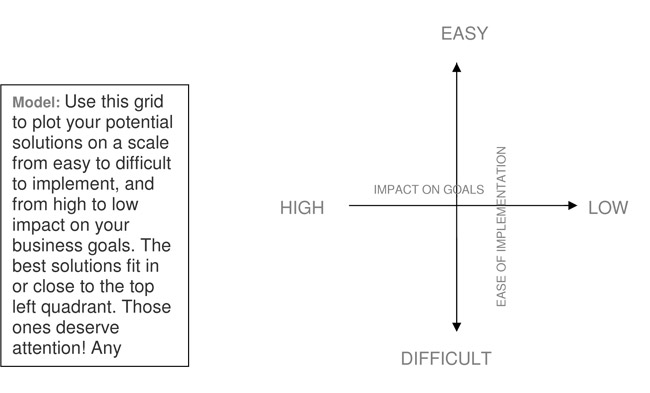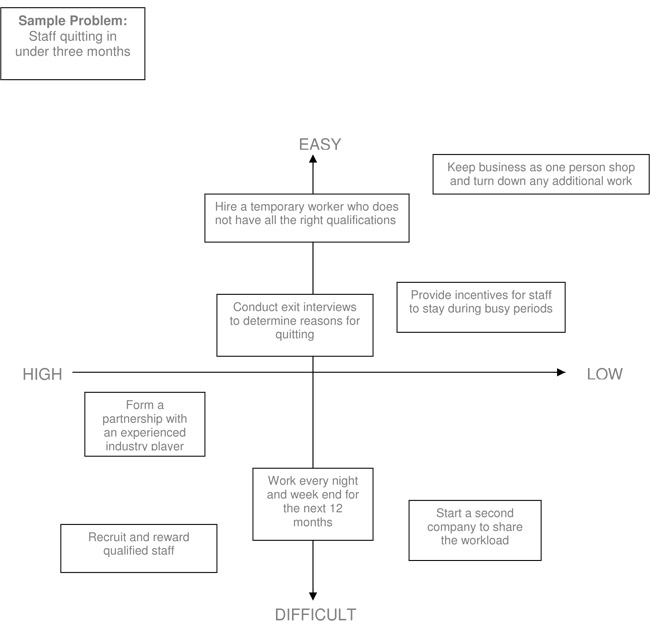- Mentoring
Business Problem-Solving
Follow this approach to problem solving to find rewarding and low-risk solutions in your mentoring relationship.
Very rarely do entrepreneurs find quick, easy and long-lasting solutions to business problems. Most problems are complex and must be analyzed from a number of perspectives before solutions can be generated. However, by following a systematic approach to problem solving, entrepreneurs and their mentors can build a deeper understanding of specific business problems and find solutions that provide the biggest reward with the lowest risk.
There are three main steps in solving business problems:
- Identify the problem.
- Consider your options.
- Choose the best solution.
Step 1: Identify the Problem
At times, you may be too tightly wound up in your business to notice a problem, especially at the early stages. Even when you start to think something’s wrong, you still might not know what the real problem is. Some problems are actually symptoms of other more complex problems. Consider this example:
- Entrepreneur: “I have a big problem. I don’t have enough staff to do all the work my company has committed to.”
- Mentor: “Why don’t you have enough staff? You hired three new employees last quarter.”
- Entrepreneur: “They all quit. That’s my problem!”
It’s important to understand the causes of the problem, rather than simply looking at its effects. Here is a process for problem identification:
Ask “why?” until an answer cannot be provided. By asking “why?”, you back up to the true cause of the problem. In a continuation of the example above:
- Mentor: “Why did all your staff quit?”
- Entrepreneur: “I don’t know.”
- Mentor: “OK, now we’re getting to your problem.”
State the problem. For example: Staff quitting in under three months.
Develop a detailed problem description by answering the following questions:
- When did the problem first appear?
- What factors or events led to this problem?
- What factors or events made the problem more evident?
- How and to what extent is this problem affecting the business?
With a clear understanding of the nature and extent of the problem, you can move on to Business Problem Solving Step 2: Consider Your Options.
Step 2: Consider Your Options
Even when problems are correctly identified, they are often not given the attention they deserve nor the action they require. Once you know what the
problem really is, you must take action to solve it. Try this approach to come up with some potential solutions to act upon:
Consider the specific factors that must be addressed in the solution. By spending some time looking at the problem from an open and objective perspective, you will be able to generate a clearer picture of the factors that need to be addressed in the solution. Create two vertical columns on a page. In the left column, list all the factors you can think of.
Identify potential solutions that address most or all of the factors. In the right column of the page, write down potential solutions beside each factor to be addressed. Be creative!
With several potential solutions identified, you can move on to Step 3: Choose the Best Solution.
Step 3: Choose the Best Solution.
Evaluate the alternatives. Use the grid on the following page to help you evaluate your options. For each potential solution, determine where on the grid it fits, according to how easy it would be to implement and what level of impact the solution would likely have on your business goals. With this analysis, you can narrow down your alternatives and select one or two tentative solutions.
Weigh the risks of your tentative solutions. This is your opportunity to prepare for and take steps to avoid any potential negative effects of your final decision, at no cost.
For each of your alternatives, ask yourself the following questions:
- What RISKS do you see in the solution? Or in other words, what could go wrong?
- How would you MITIGATE the risk?
- Who would take the RESPONSIBILITY to mitigate the risk?
Choose the most appropriate solution to implement. This should be easier by now!
Adapted from The New Rational Manager, Charles Kepner & Benjamin Tregoe




